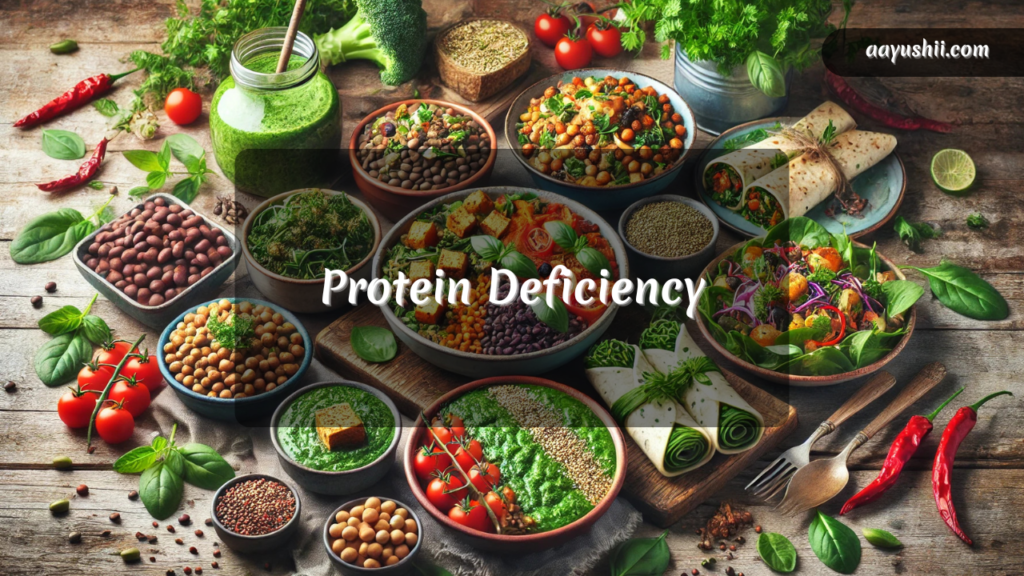Protein is a vital macronutrient that plays an essential role in practically every cell of the human body. From the structure of our muscles and tissues to the production of enzymes and hormones, protein is involved in countless physiological processes. Despite protein’s undisputed importance, many people around the world still fail to meet their daily protein requirements, leading to a condition commonly referred to as protein deficiency.
Protein deficiency can have far-reaching consequences for overall health, including decreased muscle mass, impaired immune function, and slower wound healing. Fortunately, there are numerous strategies to prevent and address protein deficiency, ranging from mindful dietary choices to leveraging the power of herbs in meal preparation.
In this article you’ll learn everything you need to know about protein deficiency, why protein is so crucial for muscle health, and how to incorporate herbs into delicious, protein-rich meals. We will start by diving into the fundamental concepts and real-world implications of protein deficiency. Then we’ll move on to cover the exact role of protein in muscle building and other bodily functions, giving you insights into what it means to optimize your protein intake from herbal and plant-powered sources. Finally, we’ll reveal five herbal-focused meal ideas to help you cultivate strong, healthy muscles naturally.
By the end, you’ll have a deeper understanding of how to protect yourself against protein deficiency and how to cook meals that power your body from the inside out.
Table of Contents
Understanding Protein Deficiency
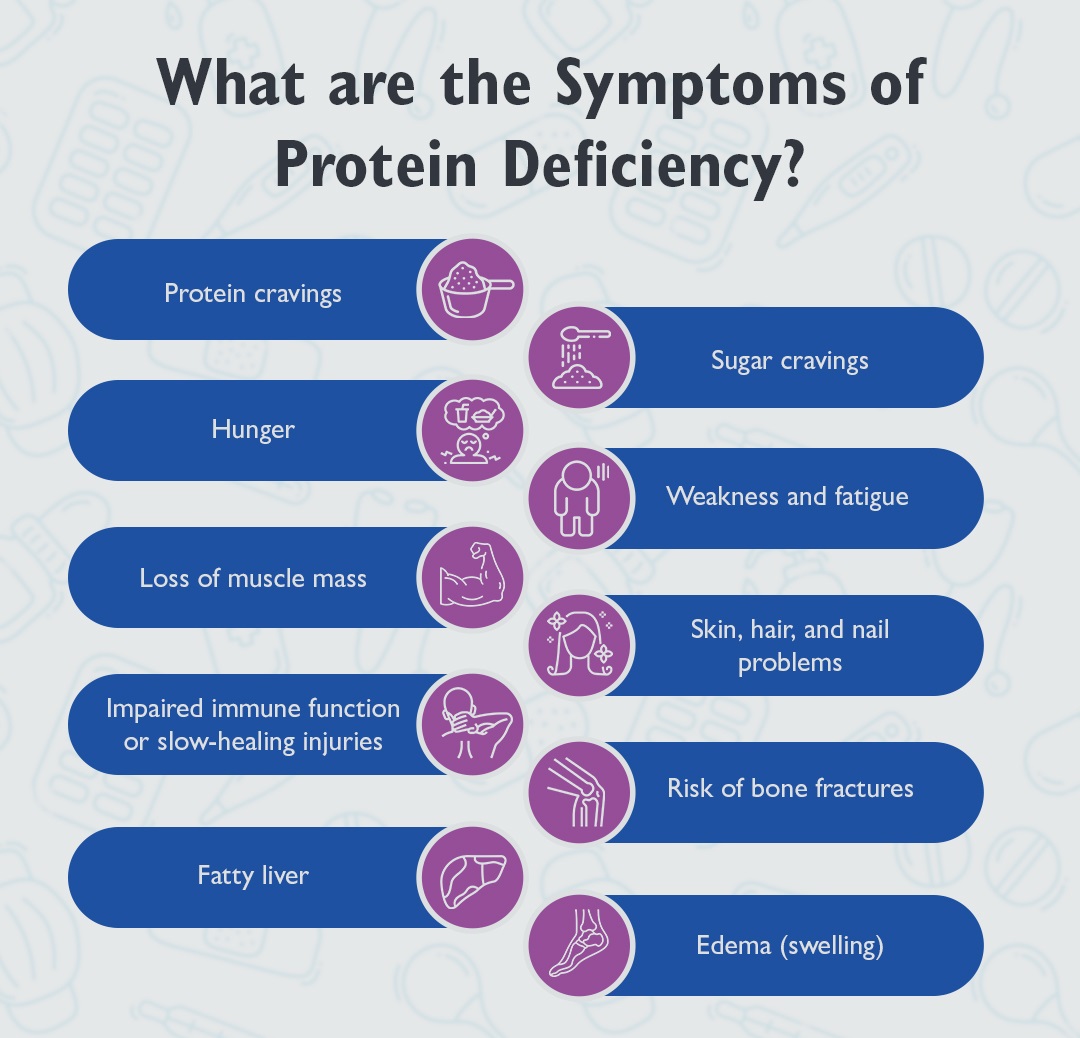
Protein deficiency is a form of malnutrition wherein a person does not consume an adequate amount of protein to meet their body’s needs. Proteins are made up of amino acids, which are often referred to as the “building blocks” of the body. These amino acids are involved in numerous biological functions, such as:
- Building and repairing tissues (including muscles)
- Forming enzymes and hormones
- Supporting immune system function
- Transporting nutrients and oxygen in the bloodstream
- Maintaining fluid balance within cells
When your dietary protein intake falls significantly short, the body starts to prioritize vital functions such as fueling essential organs at the expense of non-essential tissues like skeletal muscle. Over time, consistent lack of protein can trigger a myriad of health issues and hinder physical performance.
Key Symptoms of Protein Deficiency
Protein deficiency can manifest through various signs and symptoms, which may range from mild to severe depending on the extent and duration of the deficiency. Recognizing these symptoms is crucial:
- Muscle Wasting (Muscle Atrophy)
One of the earliest and most prominent signs of protein deficiency is a gradual loss of muscle mass. Without sufficient protein, muscle tissues are broken down to supply amino acids for other critical bodily functions. - Edema (Swelling)
Protein, especially albumin, helps regulate fluid balance in the body. Insufficient albumin can lead to edema, which often shows as swelling in the feet, ankles, or belly. - Fatigue and Weakness
Protein deficiency can make you feel tired and weak. You might notice a drop in stamina and endurance, making everyday tasks more challenging than usual. - Delayed Healing of Wounds
Proteins are crucial for tissue repair. If cuts, bruises, or surgical wounds heal more slowly, it can be a sign your body is not getting enough protein. - Frequent Infections
An underperforming immune system is another consequence of protein deficiency. You may experience frequent colds, bacterial infections, or other signs of compromised immunity. - Brittle Hair, Skin, and Nails
Protein is a key component in keratin—a structural protein found in hair, skin, and nails. Inadequate intake can lead to brittle nails, hair thinning, and dryness or flaking of the skin. - Mood Changes
Neurotransmitters are built from amino acids. Insufficient protein can alter neurotransmitter production, potentially leading to anxiety, mood swings, or depression in some individuals.
Causes and Risk Factors
There are numerous factors that might contribute to a lack of adequate protein in the diet. Some of the most common include:
- Poverty and Food Insecurity: Limited access to protein-rich foods, particularly in regions where income or resources are scarce.
- Strict Dietary Choices: Certain restrictive eating patterns or poorly planned vegetarian/vegan diets can lack adequate protein sources.
- Malabsorption Issues: Gastrointestinal conditions like Crohn’s disease or celiac disease can impede protein absorption.
- Eating Disorders: Conditions such as anorexia nervosa or bulimia can lead to severely low protein intake.
Being aware of these risk factors allows individuals to take preemptive measures to prevent protein deficiency, such as diversifying food sources or working with healthcare providers.
Global Statistics and Insights
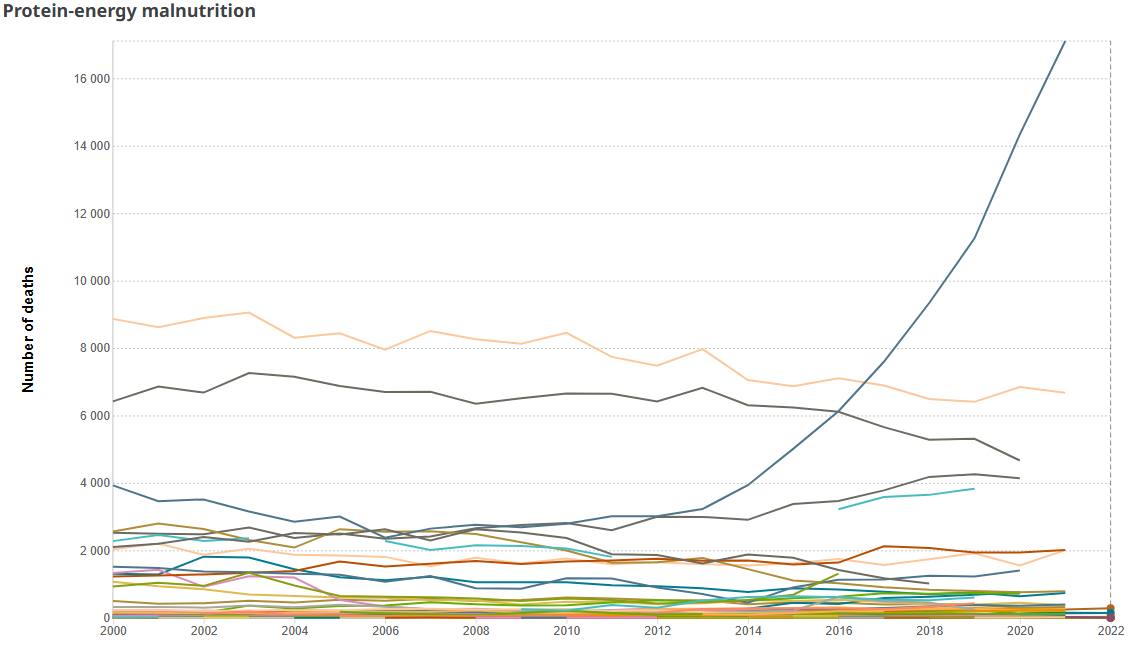
According to the World Health Organization (WHO), protein-energy malnutrition is a significant concern in many low-income countries. Additionally, even in wealthier nations, certain population groups—such as older adults living alone or those following extremely restrictive diets—may experience subclinical protein deficiency. Although the exact statistics vary by source and region, the World Health Organization estimates that around 10-15% of the global population might be impacted by inadequate protein intake in one form or another.
Why Protein is Crucial for Muscle Health
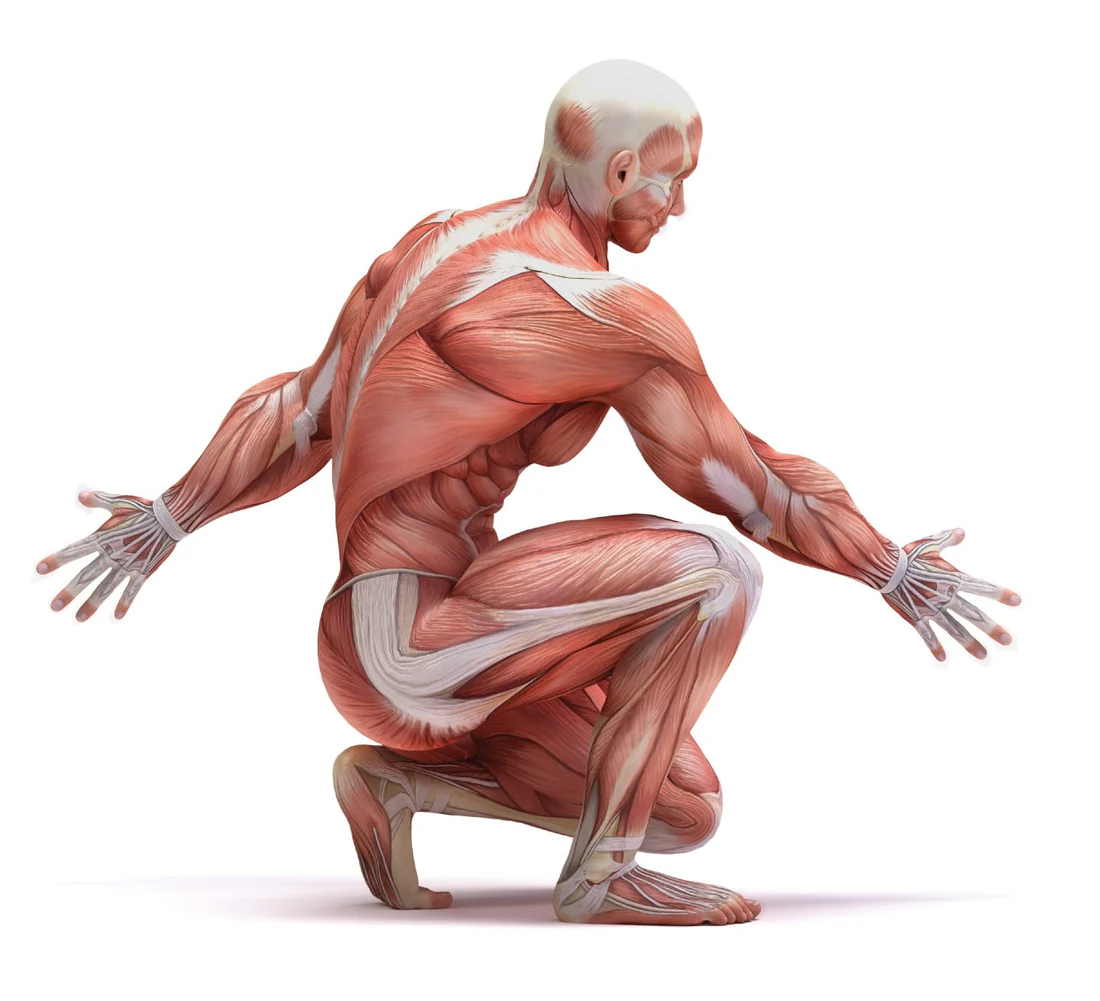
Muscle Protein Synthesis Explained
“Muscle protein synthesis” (MPS) is the process by which your body converts dietary protein into muscle tissue. When you consume protein, your body breaks it down into amino acids. These amino acids then enter a complex interplay with your muscle cells to repair and grow muscle fibers—especially after activities that cause muscle micro-tears, such as resistance training or high-intensity exercises.
For optimal muscle growth and maintenance, there must be a balance between muscle protein synthesis (the building of new muscle) and muscle protein breakdown. A well-timed and adequate intake of protein can shift this balance toward net positive muscle protein synthesis.
Role of Amino Acids
Amino acids come in two primary categories:
- Essential Amino Acids (EAAs): These cannot be synthesized by the body and must be obtained from the diet. Examples include leucine, valine, and lysine.
- Non-Essential Amino Acids: The body can produce them on its own, but dietary intake can still be beneficial under certain conditions.
A dietary pattern that provides all nine essential amino acids in adequate amounts is often referred to as a source of complete protein. While animal-based proteins (e.g., eggs, dairy, meat, fish) are typically complete, several plant-based proteins require combination with other foods to become complete. For instance, combining legumes with grains (like black beans with rice) can yield a complete amino acid profile.
Daily Protein Requirements
The recommended dietary allowance (RDA) for protein is about 0.8 grams of protein per kilogram of body weight for the average sedentary adult. However, this number can vary widely based on individual factors:
- Activity level (endurance vs. strength training)
- Age
- Body composition goals (losing weight, gaining muscle mass)
- Overall health and medical conditions
Many fitness experts suggest aiming for 1.2 to 2.0 grams of protein per kilogram of body weight for those looking to build muscle or maintain a more active lifestyle. Although these are general guidelines, consulting a nutritionist or dietitian can help in creating a personalized protein intake plan.
Protein Timing and Distribution
Modern research suggests that distributing protein intake fairly evenly throughout the day (as opposed to one or two protein-heavy meals) can be more beneficial for muscle protein synthesis. For example, if you aim to consume 90 grams of protein per day, splitting it into three meals of about 30 grams each (plus small protein-rich snacks) may deliver more consistent amino acid availability for muscle repair and growth.
Effects of Protein Deficiency on the Body

Musculoskeletal Impact
Insufficient protein leads to decreased muscle synthesis and potential muscle atrophy. Over time, chronic low-protein intake can reduce muscle strength, endurance, and functionality. Joints and ligaments may also be affected because protein deficiency can hinder collagen production—leading to a heightened risk of injury.
Immune System and Hormonal Balance
Proteins create antibodies that help the body ward off infection. With a shortage of dietary protein, antibody production can be compromised, making you more susceptible to illness. On the hormonal side, protein is essential for producing hormones like insulin, growth hormone, and thyroid hormones. A deficiency can disrupt metabolic homeostasis, energy regulation, and growth processes.
Hair, Skin, and Nail Health
Keratin is a protein that fortifies hair and nails. It also provides some structure to the skin. Protein deficiency can result in weakened hair shafts, splitting nails, and skin that is dull, dry, or prone to lesions.
Other Long-Term Consequences
Severe protein deficiency over a long period can contribute to:
- Organ Failure: The heart, liver, and lungs rely on adequate protein to maintain tissue integrity and function.
- Stunted Growth in Children: Insufficient protein intake can impede normal growth and cognitive development.
- Kwashiorkor: This is a serious condition characterized by edema, liver enlargement, and overall malnutrition, predominantly found in regions of extreme poverty and food insecurity.
Who is Most At Risk?

Populations and Lifestyles Linked to Protein Deficiency
- Elderly Individuals
As people age, their appetite and digestive efficiency often decline, which can lead to inadequate protein intake. - Individuals in Low-Income Regions
Due to limited access to protein-rich foods like dairy, legumes, and meat. - People Following Restrictive Diets
Poorly planned vegetarian, vegan, or other specialized diets could lack sufficient high-quality protein sources. - High-Performance Athletes
Although athletes are typically well-informed about nutrition, some might still fall short due to very high protein demands that aren’t adequately met. - People with Chronic Diseases
Certain conditions like kidney disease, Crohn’s disease, or gastrointestinal disorders can impair protein absorption and utilization.
Dietary Restrictions, Food Accessibility, and Economic Factors
Protein-rich foods such as fish, lean meat, dairy, or specialized protein powders can be expensive. In regions where food resources are limited, grains and cereals high in carbohydrates become staples by default, leading to nutritional imbalances that include low protein intake. Similarly, in areas where fresh produce and legumes are limited, it’s more challenging to construct a diverse diet that provides all essential amino acids.
Cultural and Personal Eating Habits
Cultural traditions or personal beliefs may emphasize carbohydrate-rich foods (like rice, bread, or potatoes) as the primary calorie source, sometimes overshadowing the importance of protein. It’s crucial to adapt recipes and meal routines to ensure proteins and complementary foods are included to provide a full spectrum of amino acids.
Herbal-Focused Nutrition and Its Benefits
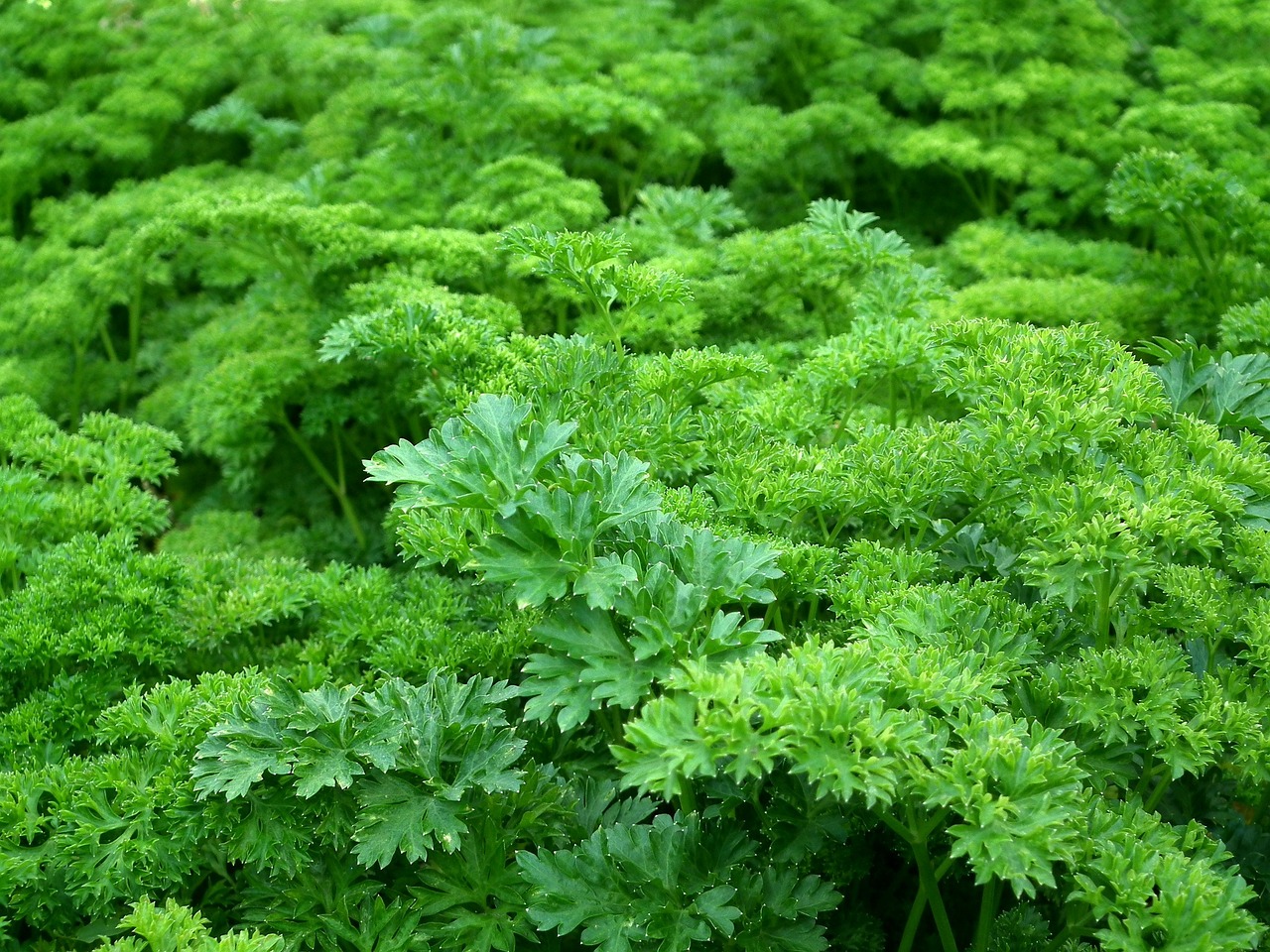
An “herbal-focused” meal plan is one that emphasizes the usage of various herbs—culinary, medicinal, or both—to enhance the flavor profile and nutritional density of meals. In many cuisines, herbs like basil, parsley, cilantro, thyme, oregano, and rosemary are used to complement and elevate the taste. Beyond taste, many herbs deliver antioxidants, vitamins, and phytochemicals, which offer a range of potential health benefits.
The Nutritional Potential of Herbs
While herbs may not drastically increase the protein content of a dish, they do contribute valuable micronutrients and bioactive compounds that can support overall health:
- Antioxidants: Many herbs are rich in antioxidants which help combat oxidative stress and reduce inflammation.
- Minerals and Vitamins: Herbs often contain small but significant amounts of vitamins A, C, K, and minerals like iron, calcium, or magnesium.
- Phytonutrients: Unique compounds such as rosemary acid (in rosemary) or allicin (in garlic) can support immune function and other aspects of health.
Herbs vs. Spices: Differences and Overlaps
Although the terms “herbs” and “spices” are often used interchangeably, there are distinctions:
- Herbs: Typically the leafy green parts of a plant (e.g., basil leaves or parsley leaves).
- Spices: Usually derived from the non-leafy parts, such as roots (ginger), stems (cinnamon bark), seeds (cumin), or fruits (black peppercorns).
Both herbs and spices can elevate a meal’s nutrient profile and deliver a deliciously complex flavor. Integrating a variety of herbs and spices into your cooking routine can add depth and variety, encouraging a more satisfying culinary experience that supports consistent, healthy eating habits.
Incorporating Herbs into Protein-Rich Meals
Below are several tips on how to include herbs in a way that can help ensure both taste and nutritional balance:
- Pair Herbs with Legumes
Legumes like lentils, beans, and chickpeas are plant-based protein powerhouses. Adding fresh herbs such as parsley, basil, or cilantro can enhance flavor and provide extra nutrients. - Marinades and Rubs
For those who eat meat, poultry, fish, or plant-based alternatives like tofu or tempeh, creating marinades with herbs (e.g., rosemary, thyme, and oregano) can penetrate the protein sources with rich flavor while adding functional compounds. - Green Smoothies and Juices
Incorporate mild-tasting herbs like parsley or cilantro along with protein from sources like Greek yogurt, hemp seeds, or pea protein powder for a quick, nutrient-rich boost. - Soups, Stews, and Curries
Herbs can be added at various stages of cooking. Robust herbs like rosemary or thyme can withstand prolonged cooking, whereas delicate herbs like basil or cilantro typically go in near the end to preserve flavor and nutrients.
5 Herbal-Focused Meal Ideas for Strong Muscles
Below are five creative, plant-centric meal ideas that incorporate herbs to support your protein needs and muscle health. Each dish is designed to be nutritionally balanced, featuring protein-rich ingredients, complex carbohydrates, healthy fats, and of course, plenty of herbs to boost taste and offer a variety of micronutrients. Feel free to adjust the portion sizes based on your individual needs.
1. Hearty Lentil and Spinach Curry with Fresh Herbs
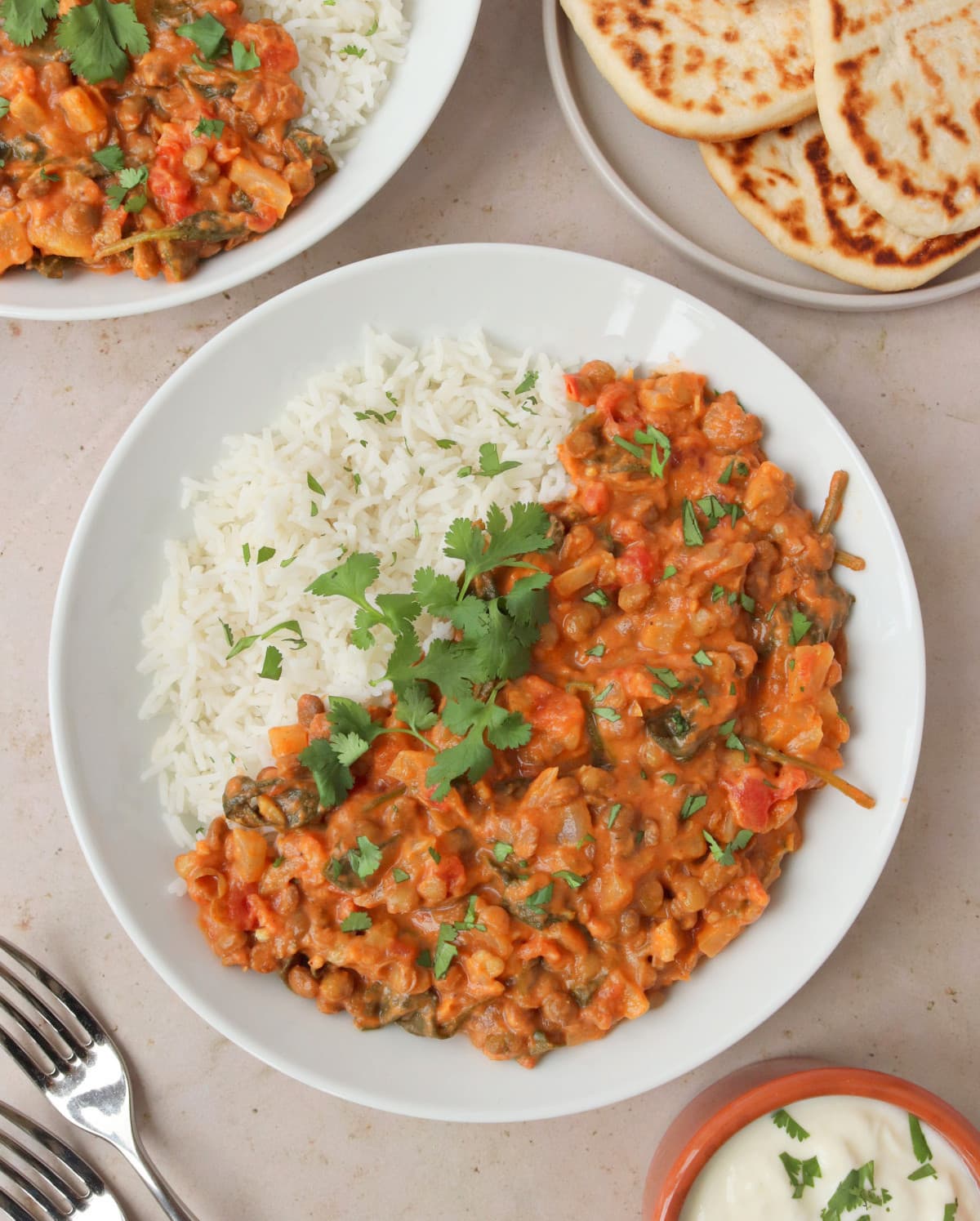
Lentils are an outstanding plant-based protein source. Spinach adds vitamins, minerals, and antioxidants, while a blend of herbs and spices ties everything together. This simple curry can be served with whole grains like brown rice, quinoa, or whole-grain roti.
Key Ingredients
- Lentils (red or brown): ~1 cup dried
- Spinach: 2 to 3 cups fresh (or 1 cup frozen)
- Onions and tomatoes: 1 onion (diced), 2 tomatoes (chopped)
- Garlic and ginger: 2-3 cloves garlic (minced), 1 inch ginger (grated)
- Herbs: Fresh cilantro (or parsley) for garnish; dried fenugreek leaves (optional)
- Spices: Turmeric, cumin, coriander powder, chili powder, salt, and black pepper
- Oil: 1-2 tablespoons olive oil or coconut oil
- Vegetable broth (or water): 2-3 cups
Detailed Preparation
- Rinse and Soak: Rinse the lentils until the water runs clear. Soaking them for 15-20 minutes can reduce cooking time.
- Sauté Base: Heat the oil in a pot and sauté diced onion until translucent. Add garlic, ginger, and spices (turmeric, cumin, coriander, chili powder) to bloom the flavors.
- Add Tomatoes: Stir in chopped tomatoes and let them cook until they start to break down, forming a thick sauce.
- Cook Lentils: Drain the soaked lentils and add them to the pot. Pour in 2-3 cups of vegetable broth or water. Bring to a gentle boil, then reduce heat and simmer for 20-30 minutes (or until the lentils are tender).
- Incorporate Spinach: Stir in fresh spinach leaves. If using frozen spinach, thaw it first.
- Herbal Finish: Turn off the heat and fold in chopped fresh cilantro or parsley. Optional: crush dried fenugreek leaves between your palms and sprinkle on top for a restaurant-style aroma.
- Serve: Garnish with extra fresh cilantro or parsley. Enjoy alongside brown rice or whole-grain roti.
Nutritional Benefits
- High in Protein: Lentils deliver about 18 grams of protein per cooked cup.
- Rich in Iron and Calcium: Spinach and lentils both contribute minerals that support bone health and oxygen transport.
- Phytochemical Boost: Herbs and spices contain numerous phytochemicals that can aid in digestion and provide anti-inflammatory properties.
2. Quinoa, Chickpea, and Kale Salad with Herb Vinaigrette
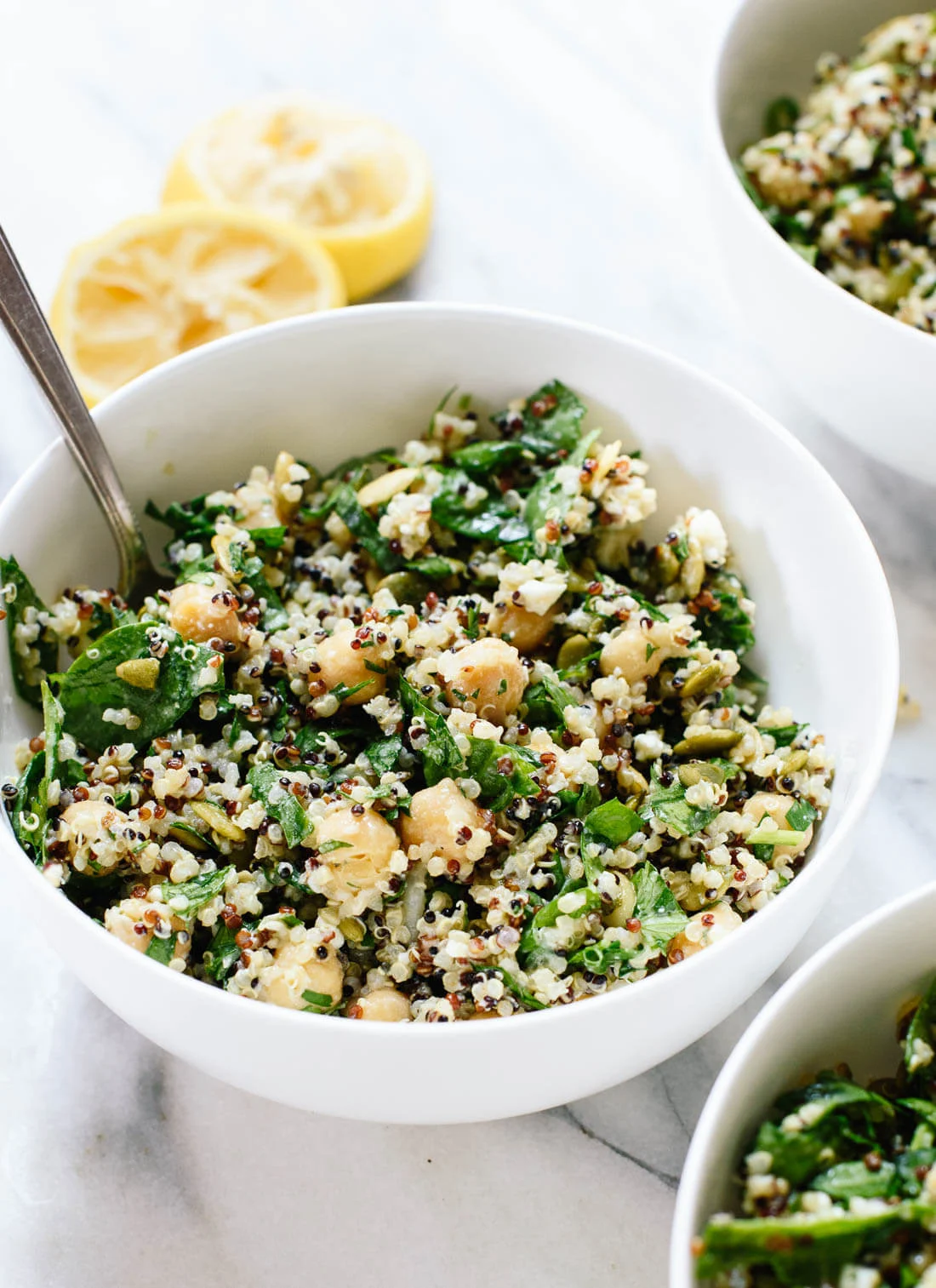
Quinoa and chickpeas join forces in this filling salad, offering complete protein (quinoa is one of the few plant foods considered a “complete” protein) and complex carbohydrates. Massaging the kale leaves with a flavorful herb vinaigrette transforms raw kale into a tender and delicious leafy green foundation.
Key Ingredients
- Quinoa: ~1 cup (dry)
- Chickpeas: 1 can (15 oz), drained and rinsed (or ~1.5 cups cooked)
- Kale: 3-4 cups, stems removed, chopped
- Bell peppers, cucumbers, or tomatoes (optional, for color and crunch)
- Herb Vinaigrette: A mixture of fresh herbs (e.g., basil, parsley), olive oil, apple cider vinegar or lemon juice, Dijon mustard, salt, and pepper
- Optional toppings: Seeds (pumpkin seeds, sunflower seeds) or nuts (almonds, walnuts)
Detailed Preparation
- Cook the Quinoa: Rinse quinoa under running water to remove bitterness. Add it to a pot with double its volume in water or vegetable broth (e.g., 2 cups of liquid for 1 cup of quinoa). Bring to a boil, then reduce heat and simmer for ~15 minutes or until the water is absorbed. Fluff with a fork and let it cool slightly.
- Prep the Kale: Remove the tough stems, chop the leaves, and place in a large bowl.
- Make the Herb Vinaigrette: In a blender or food processor, combine 1/4 cup olive oil, 2 tablespoons vinegar or lemon juice, 1 teaspoon Dijon mustard, a handful of fresh herbs (basil, parsley, or a mix), salt, and black pepper. Blend until smooth. Taste and adjust seasonings if needed.
- Massage the Kale: Pour about half the vinaigrette over the kale. With clean hands, gently massage the leaves for 1-2 minutes until they start to soften.
- Combine the Salad: Add cooked quinoa, drained chickpeas, and optional chopped veggies to the bowl with the massaged kale. Pour in the remaining vinaigrette and mix well.
- Garnish: Top with seeds or nuts for additional protein, crunch, and healthy fats.
Nutritional Benefits
- Complete Protein: Quinoa provides all essential amino acids, and chickpeas augment the protein content further.
- High Fiber: Both quinoa and chickpeas offer soluble and insoluble fiber, supporting gut health and satiety.
- Rich in Vitamins and Minerals: Kale is a powerhouse of vitamins A, C, and K, along with minerals like calcium and potassium.
3. Tofu and Veggie Stir-Fry with Thai Basil
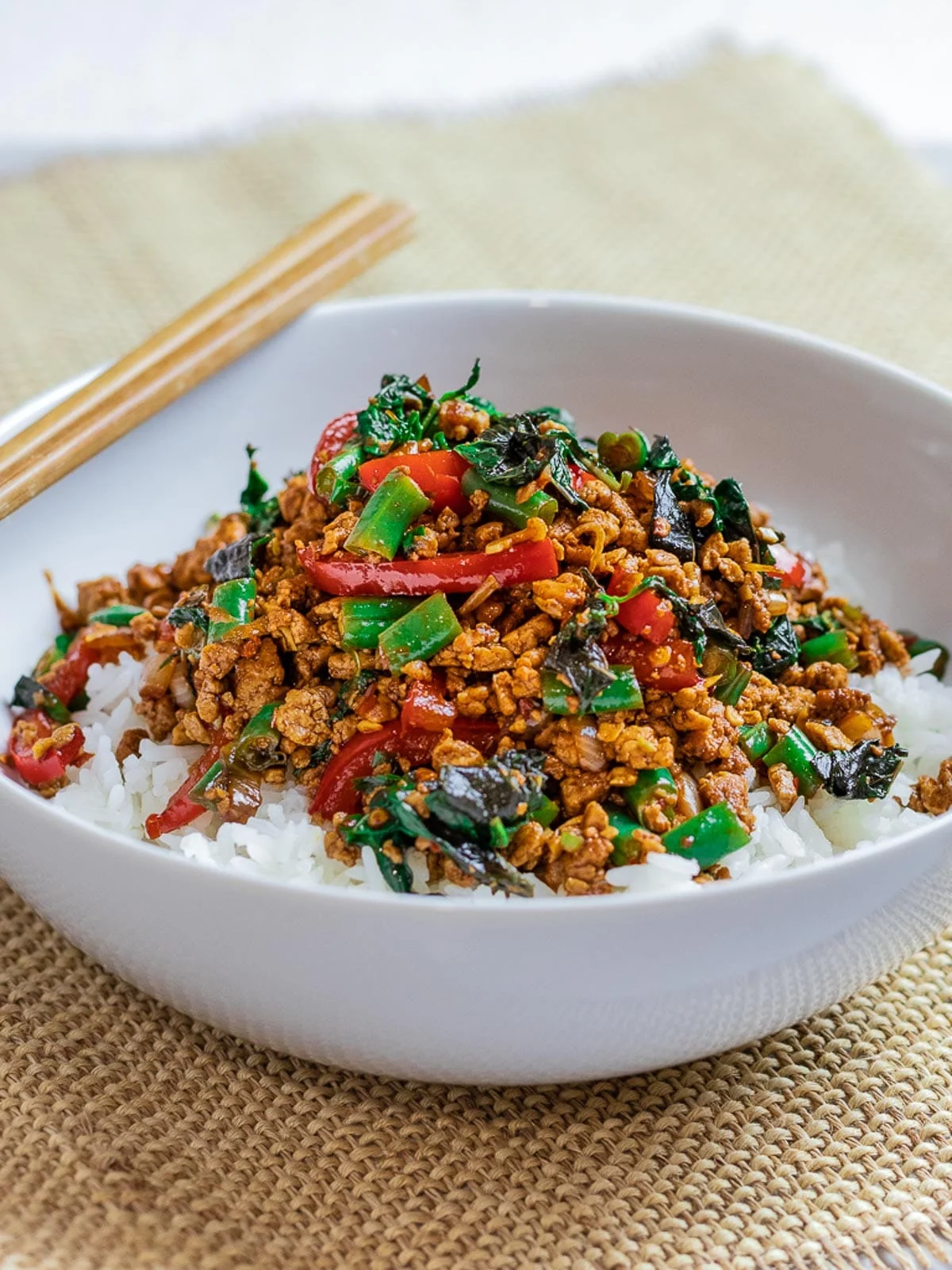
Tofu is a staple in plant-based diets, supplying a hefty dose of high-quality protein. In this dish, it’s paired with a rainbow of vegetables and Thai basil, an herb known for its slightly spicy, licorice-like flavor. Feel free to include other herbs such as cilantro or regular basil if Thai basil is not available.
Key Ingredients
- Tofu: 1 block (14-16 oz), extra firm, drained and cubed
- Mixed Vegetables: Bell peppers, onions, carrots, broccoli, mushrooms—about 4 cups chopped total
- Garlic and ginger: 2 cloves garlic (minced), 1 inch ginger (grated)
- Thai Basil Leaves: ~1 cup (loosely packed)
- Stir-Fry Sauce: Low-sodium soy sauce or tamari, a splash of rice vinegar, optional sweetener (like maple syrup), and cornstarch for thickening
- Oil: For stir-frying (e.g., peanut, sesame, or avocado oil)
Detailed Preparation
- Drain and Press Tofu: For the best texture, press the tofu for at least 15 minutes to remove excess moisture. Cut into cubes.
- Prep the Stir-Fry Sauce: In a small bowl, whisk together 3 tablespoons soy sauce, 1 tablespoon rice vinegar, a teaspoon of sweetener, and a teaspoon of cornstarch mixed in a small amount of water.
- Sear the Tofu: Heat 1-2 tablespoons of oil in a wok or large skillet over medium-high heat. Add the tofu cubes and cook until they develop a golden crust on all sides. Remove from the pan and set aside.
- Sauté Aromatics: In the same pan, add a bit more oil if needed. Sauté minced garlic and grated ginger for about 30 seconds, taking care not to burn them.
- Add Vegetables: Toss in chopped vegetables and stir-fry for several minutes until they are crisp-tender. The order can depend on vegetable hardness (carrots and broccoli often go in first, while bell peppers and mushrooms can be added later).
- Incorporate the Sauce: Return the tofu to the pan. Pour the prepared sauce over the stir-fry and toss quickly to coat all ingredients. Allow the sauce to thicken slightly.
- Add Thai Basil: Turn off the heat and gently fold in the Thai basil leaves, which will wilt from the residual heat.
- Serve: Pair with brown rice or whole-grain noodles. Optionally top with chopped peanuts or sesame seeds.
Nutritional Benefits
- High in Plant Protein: A block of tofu (14-16 oz) can contain up to 35 grams of protein or more, depending on the brand.
- Vitamins and Minerals: Leafy vegetables, peppers, and other stir-fry components supply a broad spectrum of nutrients, including vitamin C and antioxidants.
- Low in Saturated Fat: Tofu is naturally low in saturated fat, making this meal heart-healthy and weight-friendly.
4. Black Bean and Sweet Potato Wraps with Cilantro-Lime Sauce
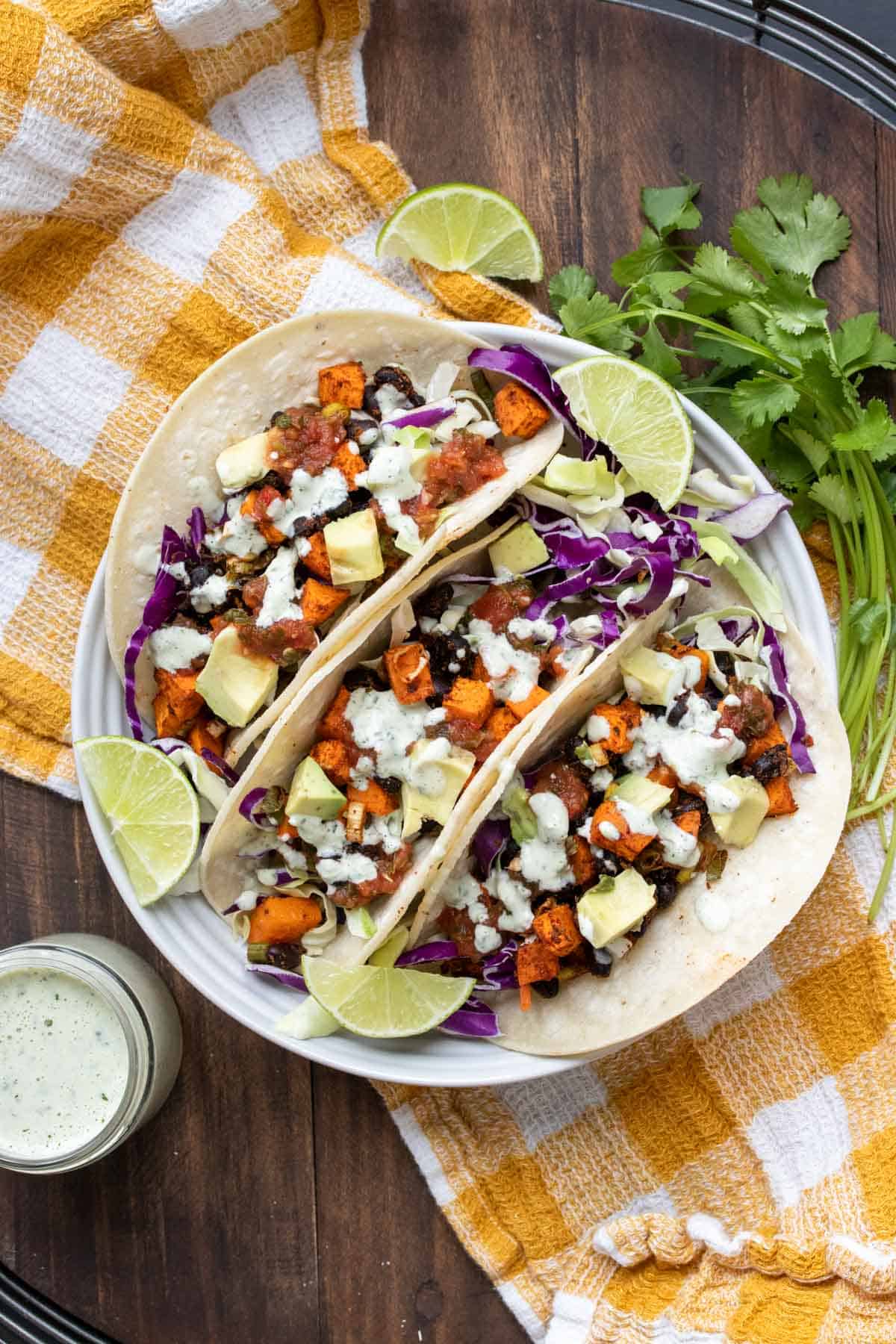
This wrap marries the earthy sweetness of roasted sweet potatoes with the hearty flavor of black beans, all uplifted by a tangy cilantro-lime sauce. Black beans are notable for their protein and fiber content, while sweet potatoes deliver complex carbohydrates, beta-carotene, and a slightly sweet taste.
Key Ingredients
- Whole-Grain Tortillas: 4-6, depending on desired serving size
- Black Beans: 1 can (15 oz), drained and rinsed (or ~1.5 cups cooked)
- Sweet Potatoes: 2 medium, peeled and diced into cubes
- Onion and Bell Pepper: Optional additions for flavor and texture
- Cilantro-Lime Sauce: Fresh cilantro, lime juice, plain yogurt (dairy or non-dairy), garlic, salt, and pepper
- Spices: Chili powder, cumin, paprika, salt, pepper
- Oil: For roasting sweet potatoes and sautéing veggies
Detailed Preparation
- Roast the Sweet Potatoes: Preheat your oven to 400°F (200°C). Toss diced sweet potatoes with a tablespoon of oil, chili powder, cumin, paprika, salt, and pepper. Spread them evenly on a baking sheet and roast for 20-25 minutes or until tender.
- Sauté Onions and Peppers (Optional): In a skillet, heat a little oil and sauté sliced onions and bell peppers. Season lightly with salt and pepper.
- Warm the Black Beans: You can heat the beans in a small pot with a splash of water or vegetable broth, seasoning them lightly with salt or extra spices.
- Prepare the Cilantro-Lime Sauce: In a blender or food processor, blend 1 cup of fresh cilantro, juice of 1 lime, 1 clove of garlic, 1/2 cup plain yogurt (dairy or non-dairy), salt, and pepper to taste. Adjust thickness by adding a bit of water or more yogurt.
- Assemble the Wraps: Warm the tortillas. Layer black beans, roasted sweet potato, sautéed onions and peppers (if using), then drizzle the cilantro-lime sauce on top.
- Roll and Serve: Fold the tortilla’s sides inward, then roll it up tightly. Slice in half if desired and enjoy.
Nutritional Benefits
- Solid Protein Content: Black beans supply around 15 grams of protein per cup.
- Complex Carbohydrates: Sweet potatoes have a low glycemic index and deliver fiber, potassium, and vitamins A and C.
- Flavorful and Nutrient-Dense Sauce: The cilantro-lime yogurt sauce adds tanginess plus additional micronutrients from fresh cilantro.
5. Tempeh and Veggie Bowl Infused with Moringa and Parsley
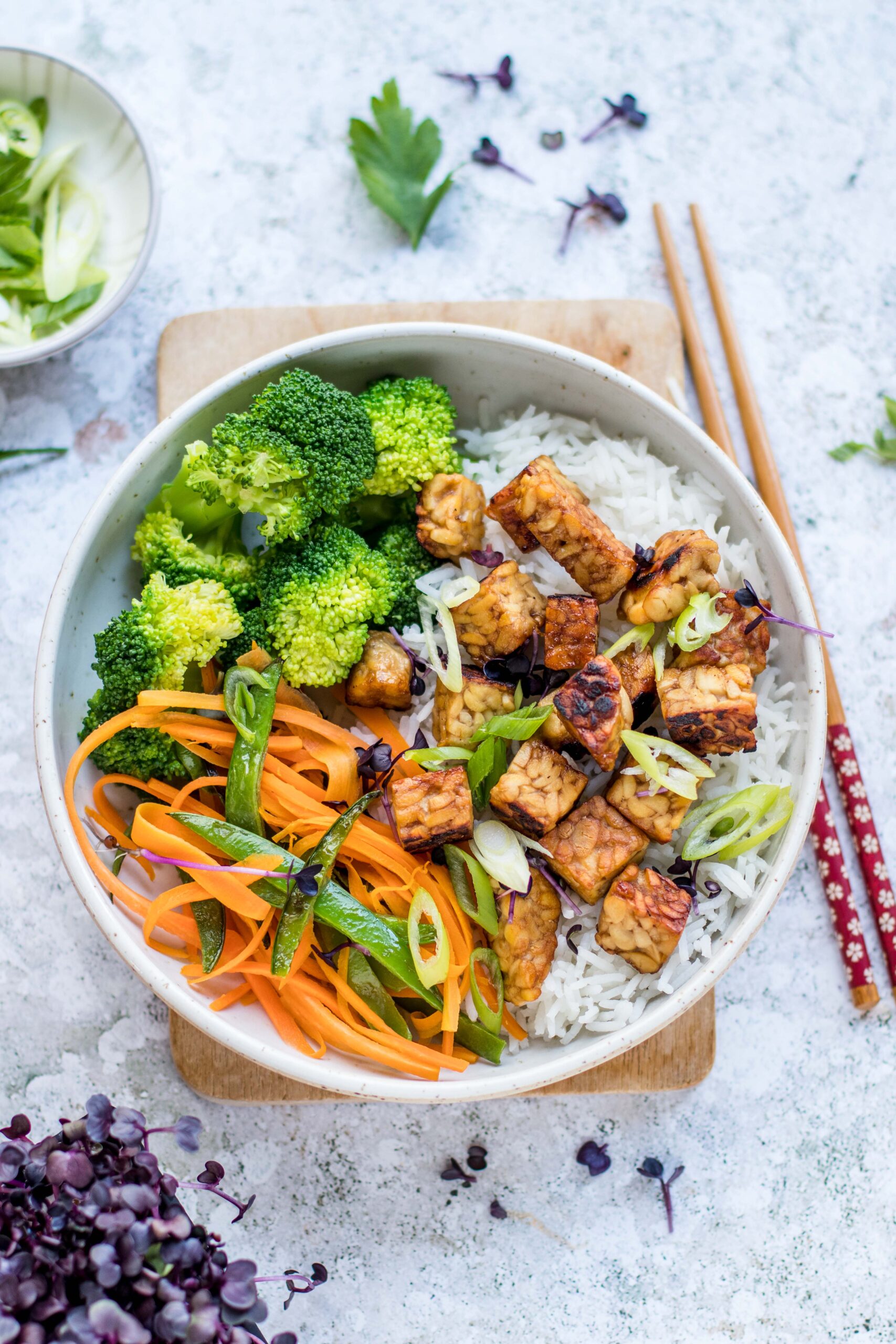
Tempeh is a fermented soybean product that provides a unique, earthy flavor and plenty of protein. Moringa leaves (fresh or powdered) are hailed in many cultures for their remarkable nutrient density, containing protein, vitamins, and minerals. This bowl also includes fresh parsley, another herb full of vitamins and antioxidants. This meal idea can be a one-bowl wonder, featuring whole grains, veggies, and a tasty sauce.
Key Ingredients
- Tempeh: ~8 oz (1 standard package), sliced or cubed
- Whole Grain Base: Brown rice, farro, barley, or quinoa
- Vegetables: Carrots, broccoli, zucchini, or any other favorites (about 3-4 cups)
- Moringa: 1 tablespoon powder or 1 cup fresh leaves (if available)
- Fresh Parsley: 1/2 cup chopped, divided (some for cooking, some for garnish)
- Seasonings: Garlic, onion powder (or fresh onions), salt, pepper
- Sauce: A combination of tamari (or soy sauce), a teaspoon of mustard, and a pinch of sweetener (like agave or honey)
Detailed Preparation
- Marinate Tempeh: Slice or cube the tempeh. In a small bowl, mix 2 tablespoons tamari, 1 teaspoon mustard, 1 teaspoon sweetener, a pinch of black pepper, and some chopped parsley. Let the tempeh soak in this marinade for at least 15 minutes.
- Cook Whole Grains: Prepare your chosen grain according to package instructions.
- Sauté or Steam Veggies: Cook the vegetables until tender. If steaming, you can season them after cooking. If stir-frying, use a small amount of oil or vegetable broth.
- Cook the Tempeh: In a skillet, lightly brown the marinated tempeh on both sides. If you prefer a crispier texture, add a bit of oil. Otherwise, you can sauté in the leftover marinade.
- Moringa Integration:
- If using moringa powder, you can add it to the tempeh just before finishing, stirring it in to coat the pieces.
- If using fresh moringa leaves, blanch them quickly or add them to the sautéed vegetables.
- Assemble the Bowl: Start with a scoop of cooked grains, layer the vegetables, then place the tempeh on top. Garnish generously with fresh parsley and a drizzle of leftover sauce if desired.
Nutritional Benefits
- High-Protein Base: Tempeh is revered for its high protein content (roughly 18-20 grams per 3 oz serving).
- Moringa’s Nutritional Power: Often called a “superfood,” moringa provides a host of vitamins, minerals, and phytonutrients.
- Gut Health: The fermentation process in tempeh can promote beneficial gut bacteria.
How to Prevent and Address Protein Deficiency
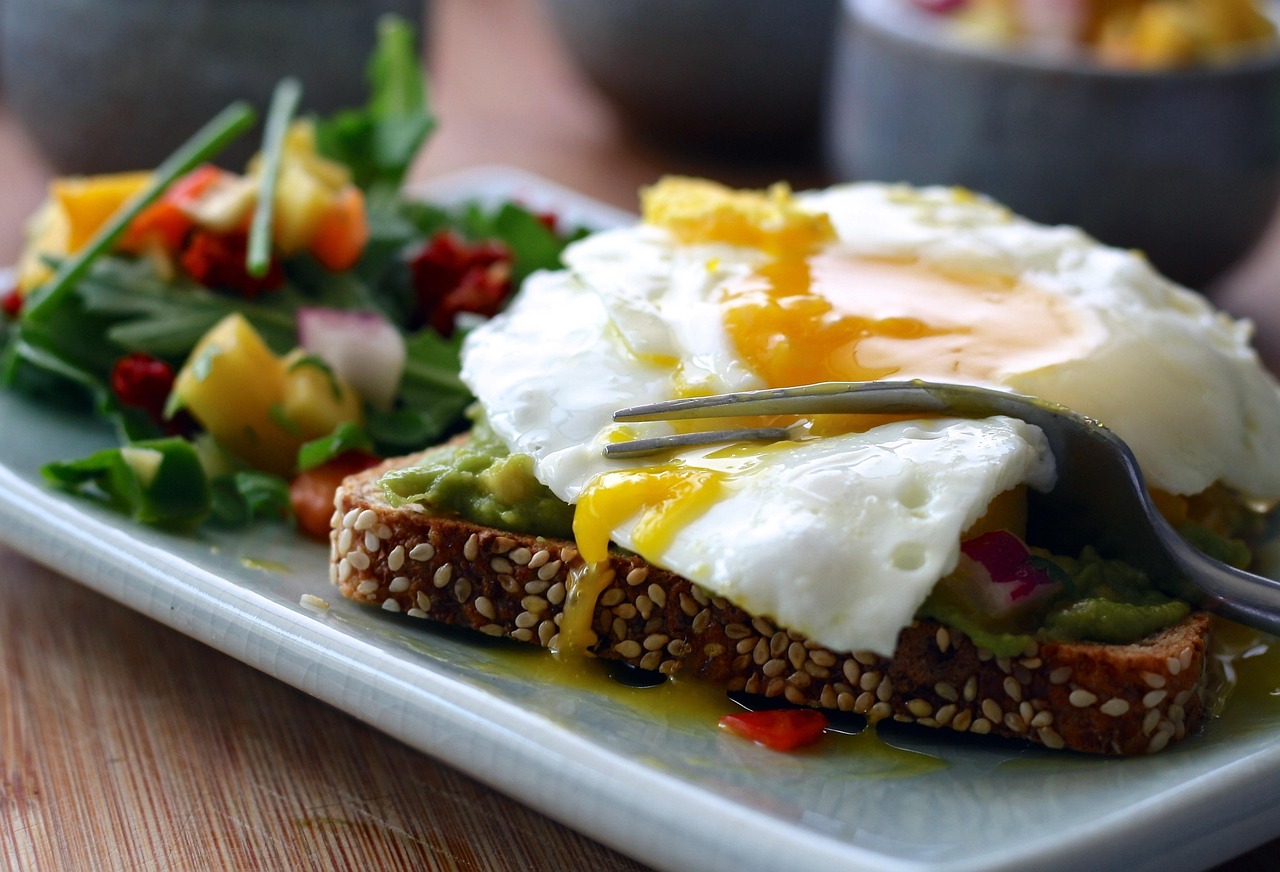
Balancing Macronutrients and Micronutrients
To maintain muscle health and ward off protein deficiency, it’s essential to balance all macronutrients: protein, carbohydrates, and fats. Excess carbs without adequate protein can lead to nutritional imbalance, while excessive protein with insufficient carbs or fats may also pose health concerns. Adequate intake of micronutrients—vitamins, minerals, and antioxidants—is similarly vital for overall well-being.
Meal Planning and Preparation
- Plan Ahead
- Map out meals for the week. This ensures you incorporate diverse protein sources and prevents impulsive, nutritionally poor choices.
- Batch Cooking
- Prepare large batches of protein-rich foods like beans, lentils, quinoa, or tempeh on the weekend. Store them in the fridge or freezer for quick assembly during busy weekdays.
- Include Protein in Every Meal
- Aim for a balanced distribution. Incorporate protein in breakfasts (e.g., scrambled tofu, Greek yogurt, or protein smoothies), lunches, snacks (e.g., nuts, seeds, roasted chickpeas), and dinners.
- Portion Control
- Use measuring cups, a kitchen scale, or intuitive portioning to meet your daily protein goals without excessive caloric intake.
The Importance of Variety and Moderation
While focusing on protein is crucial, variety is the key to a well-rounded diet. Rotate protein sources (legumes, tofu, tempeh, eggs, fish, lean meats if non-vegetarian, etc.). Pair complementary foods (e.g., beans and rice, or lentils and whole wheat bread) to ensure a full amino acid profile. At the same time, moderate your intake of refined sugars, saturated fats, and overly processed foods.
Practical Tips for Meeting Protein Goals
- Keep Quick Options Handy: Store protein bars, high-protein yogurts, or roasted chickpeas for on-the-go snacking.
- Smart Snacking: Choose nuts (almonds, walnuts, pistachios) or seeds (pumpkin, sunflower, hemp) for a protein boost.
- Use Protein Supplements if Needed: Plant-based protein powders (pea, brown rice, hemp) can be added to smoothies or oatmeal, but real whole foods should remain your primary source.
- Leverage Herbs and Spices: They’re low in calories but high in flavor, encouraging consistent healthy eating habits and allowing you to consume more protein-rich foods without boredom.
Conclusion
Protein deficiency can impact anyone, affecting muscle mass, immunity, and overall health. Recognizing symptoms like fatigue and slow healing is key to taking action. A balanced diet rich in diverse protein sources, complemented by nutrient-packed herbs, helps prevent deficiency and supports muscle strength.
The five herbal-focused meal ideas shared here demonstrate how easy it is to combine protein-rich foods with herbs like basil, cilantro, and moringa for both flavor and nutrition. Consistency and variety are essential—stock up on protein staples and plan balanced meals to meet your daily needs.
Whether you’re building muscle or maintaining health, prioritizing protein and herbs in your diet enhances energy, immunity, and overall well-being. Start incorporating these meals today and fuel your body for strength and vitality!
Frequently Asked Questions (FAQ)
1. What are the signs of protein deficiency?
Common signs include muscle loss, fatigue, slow wound healing, brittle hair and nails, frequent infections, and swelling (edema). Severe cases may lead to serious health complications.
2. How much protein do I need daily?
The recommended intake is 0.8 grams per kilogram of body weight for sedentary adults. Active individuals, athletes, and those building muscle may need 1.2–2.0 grams per kilogram.
3. Can I get enough protein from plant-based sources?
Yes! Plant-based proteins like lentils, beans, quinoa, tofu, tempeh, and seeds provide adequate protein when consumed in a balanced diet. Pairing foods (e.g., beans + rice) ensures a complete amino acid profile.
4. What herbs help with muscle growth and recovery?
Herbs like moringa, parsley, cilantro, basil, turmeric, and fenugreek provide antioxidants, vitamins, and anti-inflammatory compounds that support muscle repair and overall health.
5. Are herbal-focused meals effective for muscle gain?
Yes! Herbal-focused meals that incorporate protein-rich plant foods, healthy fats, and complex carbs can effectively support muscle growth, strength, and recovery.
6. What’s the best way to add more protein to my diet?
Include protein-rich meals in every meal—opt for lentils, chickpeas, tofu, tempeh, quinoa, nuts, and seeds. Smoothies with plant-based protein powders are also great for a quick boost.
7. Can herbs replace protein sources in meals?
No, herbs alone don’t provide sufficient protein, but they enhance nutrient absorption, digestion, and overall health, making your protein-rich meals even more effective.
8. Is it possible to consume too much protein?
Yes, excessive protein (especially from processed sources) can strain the kidneys and digestive system. Balance is key—focus on whole food sources and adequate hydration.
9. How do I prevent protein deficiency on a vegetarian or vegan diet?
Ensure diverse plant protein sources, including legumes, whole grains, nuts, and seeds. Consider fortified foods or supplements if needed.
10. What’s the easiest high-protein herbal meal to start with?
A lentil and spinach curry or a quinoa and chickpea salad with herb dressing are easy, nutritious, and packed with plant-based protein and essential nutrients.

